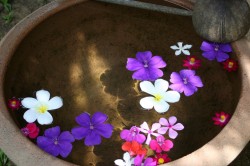Appreciation and understanding.
Aren’t they two of the most fundamental elements of a successful relationship?
When we appreciate ourselves and others, our hearts are more naturally open and we are more aligned with what there is in the world to be grateful for.
We see what is good in our lovers and we are thankful for their presence in our lives. It’s a virtuous cycle which re-inforces itself: we appreciate our lover, they (hopefully!) expand and bloom in response, which in turn brings out the best in them and helps them to treat the world around them with gratitude. And, from a place of open-hearted appreciation it is much easier to make the effort required at times to understand each other—to listen carefully, to wait patiently, to see another perspective.
~
One of the most important things you can do for your vagina and your sex life—to avoid a world of problems later? Check out this device and get a free bag of craft coffee (code; EJCOFFEE)>>
~
But stress rolls in and out of the window goes the vibration of gratitude. Stress is one of the biggest factors in relationship problems and it seems the two find it almost impossible to co-exist.
It destroys our zest for life, taking with it our sex drive, our gentleness, our humor. And, much like a computer virus, it installs in its place a critical, abrasive, detached energy. Stress causes us to shut down on all that is good in our world, and that includes our most intimate relationships. When we’re stressed, it can be really difficult to find our way back to even a whiff of gratitude.
It’s easy to say, “what if we made space and time to appreciate and understand our lovers on a regular basis?” It may seem overly simplistic but it is definitely one of the keys to creating long-lasting, happy relationships. We all experience stress—it’s just a factor of the lifestyles we lead. How we deal with it is what counts. And choosing to ignore it within a relationship until it becomes a chronic issue is leaving it too late.
One of the things I loved when I first discovered the Shamanic traditions was how ritual and ceremony offered opportunities to bring magic into our mundane lives, helping to shift our perspective and reminding us of what is really important (and, therefore, what isn’t).
Indigenous peoples had an understanding for the symbiotic relationship of all things and the importance of remembering that inter-connectedness. They also had a strong awareness of the power of gratitude. By creating regular space and time for ceremony in their lives, they managed to live with a foot in both worlds—the world of the everyday where food is cooked, work is done and children raised; and the world of the non-physical from which love emanates, magic happens and our souls connect.
This is how we need to live too, if we hunger for relationships that are soulful—infused with magic, love and respect. We need to find ways to live with a foot in both worlds.
The four simple Shamanic tools below are among my favorites to use with lovers and to recommend to others, and I have continued to use them on a regular basis since I was first introduced to them.
Each of them reinforces either our ability to be appreciative of our partner or to understand them, and they are easy to do, free and fun.
The Talking Stick.
This simplest of tools has already found its way into many homes, used with extended family members and not just between lovers. It is so effective and easy to use, though, that I had to include it here as a fore-runner to anything else.
A talking stick can be as simple as a wooden spoon which is fetched from the kitchen whenever a delicate or thorny issue needs to be discussed. Or it can be a wonderfully carved and decorated stick, complete with face, eyes and decoration which you make together as a couple.
Whatever you use, it is how it is used which is important and it is best if the stick is kept somewhere within easy reach and probably not in the kitchen drawer where the knives are!
The stick can be requested by either partner whenever they feel they feel a particular need to be listened to – and who doesn’t, at some stage. As long as one person is holding the stick, the other must listen respectfully with full attention and without interrupting. When the person holding the stick is finished, they will pass it to the listener who then has an opportunity to speak and be heard without interruption. The stick passes back and forth until both partners feel they’ve been heard.
Agreement is not the ultimate aim of using the stick – not initially, anyway. The aim is to create an atmosphere and a mechanism that feels safe for lovers to speak out and be heard.
Fire Ceremony.
The elements have always been important for human beings as a way of cleansing and of marking transition—especially fire and water. Fire ceremonies are used all over the world for a wide variety of purposes, all of which include some kind of honoring.
In this case, though, I’m suggesting that the purpose of the fire be to facilitate the letting go of anything negative which has come up during the month and to reconnect you as a couple to whatever you most need instead. Ideally, the fire is lit outside, somewhere quiet in nature, although you can also do it at home in a fireplace if you need to (I’ve even used a candle on occasion).

Full moon is a good time for increased awareness, with the new moon being a better time for release and seeding new growth (being the natural end of one cycle and the beginning of another).
Before the evening of the fire, reflect on what it is you are ready to let go of. It can be as small as a squabble or petty grudge which has poisoned the air, or as big as a life-long habit you’re ready to shift. Find a stick which you can decorate to represent what you are releasing (this is your “death arrow”). Then find another stick to decorate which will represent what you want instead (e.g. appreciation, harmonious communication, peace – your “life arrow”).
Spend some time sitting with both of these sticks, as you decorate them, feeling the energy of what you are releasing and what you wish to invite into your life instead.
As a couple, build and light the fire. Use a drizzle of olive oil or similar to honor each-other and to feed the fire, also acknowledging the energies of the four directions, earth and sky. If you want to, you can rattle, chant or clap as the fire grows. When it is fully lit, place your sticks, one at a time, on the flames—with full intention and gratitude, thinking about what they mean to you. Allow them to burn in silence as they whisk your prayers away to be transformed into reality. Then stay by the fire, soaking up its energy until it has died down to embers.
Ceremonial Bath.
In summer time, this has to be my favorite way of honoring a lover—and of being honored in return (you’ll see why I specify summer when you read on).
Ceremonial baths, like fire ceremonies, can be used for a variety of reasons but are mainly used for cleansing and marking transition. I like to use them for marking special occasions or for welcoming a lover into a new period of their life—such as becoming a parent, taking on a new job, turning a decade or after a particularly significant emotional shift. (I have full details of a bath for new mothers in Chapter 9 of The Beautiful Garden). But they can be used simply when you feel the need to honor one another as lovers, as man/woman, and to re-connect with that deeper sense of appreciation.
Although dried herbs and flowers can be used for the bath, the best way is to go for a walk in the countryside early in the morning and to personally pick a selection of non-toxic flowers and herbs. Agree beforehand what the purpose of the bath is and the herbs/flowers should be picked mindfully, holding that intention.
Lavender, chamomile, lemon balm, marigold and other common garden herbs work well, but I’ve also used meadow-sweet, gorse, wild garlic and other plants I’ve found growing in the countryside here around me. Plants carry their own healing signature and chances are you’ll naturally be guided towards the ones that will work best. Just check beforehand if there are any skin sensitivities you need to be aware of.
The flowers and herbs should then be left in a large bucket in the sunshine for the day to infuse the water. In the late afternoon or early evening, create a ceremonial circle outside with candles, etc., in a place where water can be poured freely without concern for mess. It’s called a “bath” but there is no immersion. Doing the ceremony on the banks of a stream or river is beautiful, but I’ve done it on the back patio of a small townhouse just as well.
The person to be bathed should be free of make up, wrapped in a sarong or naked, and brought with a sense of respect to the middle of the circle. They can sit on a small stool, if that is easier. Using a mug or large ladle, scoop the water up and pour it slowly over the top of the head (yes, it can be cold and yes, it runs down your face!). Then scoop up some more, pouring it over the shoulders. Continue pouring, making sure the water flows over the chest, back and every part of the body.
As the pourer works, they can say things like, “I use this bath to honor you—your heart, your soul, your essence”—or whatever words seem most appropriate for the occasion. When all the water has been poured, allow the one who has been bathed to dry off naturally, which usually means having petals and dried twigs stuck to them for hours afterward. And they shouldn’t shower until the following day to allow the energy of the bath to settle.
Shape-Shifting.
Okay, this isn’t quite as amazing as it may sound as I’m not actually talking about changing to become a bird and taking flight. But it can still be a fairly remarkable exercise for those who are naturally intuitive and able to immerse themselves in it.
The first time I used this was during a period of self-doubt, when I couldn’t see what my lover saw in me. It opened my eyes (although that’s probably not the right expression in this case) and I still use it whenever I need to understand something from another’s perspective. As a woman, there’s nothing like finding looking back at yourself through a man’s eyes to give you a completely different view!
Sit quietly side by side with your lover, holding hands lightly and closing your eyes. Sitting on the floor in a quiet room with your back to the wall works quite well. Focus on your breathing for a few moments. The intention is to swap bodies with your lover—for you to “sit” your awareness into their body and for them to do likewise.
If you have a meditation practice that brings you into the body or are used to yoga, this will probably come more naturally. Agree beforehand a signal which means you’re ready to start the “swap” (such as squeezing their hand), so that you don’t have to break the silence. Spend a few moments grounding yourself in your own body, getting a sense of how it feels right now—where it aches or feels stiff and any other noticeable sensations.
When you’re ready, signal to your partner and wait for their response. Then, using your full intention, imagine that you are moving your awareness from your own body over into theirs. Imagine what it’s like to have those arms and legs instead of your own, a different set of genitals (if you’re heterosexual), that body shape. Expand your awareness down inside this new body. How does it feel physically? What about emotionally? Once you’re used to it, turn your energetic awareness back towards the other body beside you—how does it look from a different perspective?
Play around with the exercise a bit, getting used to it. Explore the perspective, see what it can tell you or show you that you may not have been aware of. And, when you’re finished, make sure you ground yourself back fully into your own body before opening your eyes (otherwise you may feel a little disoriented). Then share what you experienced with your lover and listen to how it went for them as well.
As I present these less than common ways of enriching relationships, I can’t help wondering if some of the magic in how they work is that they bring a couple into the realm of play.
The playfulness of preparing for, and then participating in, a fire or water ceremony, never mind “body swapping,” is enough to bring back at least some of the appreciation for life we all need. The fire and bath, too, lend themselves nicely to being followed by a festive meal. I could write paragraphs on the energetic merits of the ceremonies and how they work at a non-physical level, aligning vibration and, in turn, healing our bodies and creating our world.
But it is experience that teaches better than any words so just go have some fun trying them out!
Love elephant and want to go steady?
Sign up for our (curated) daily and weekly newsletters!
Editor: Catherine Monkman
Photos: Luca Bove/Flickr, Jenny Downing/Flickr, Flickr












Read 0 comments and reply